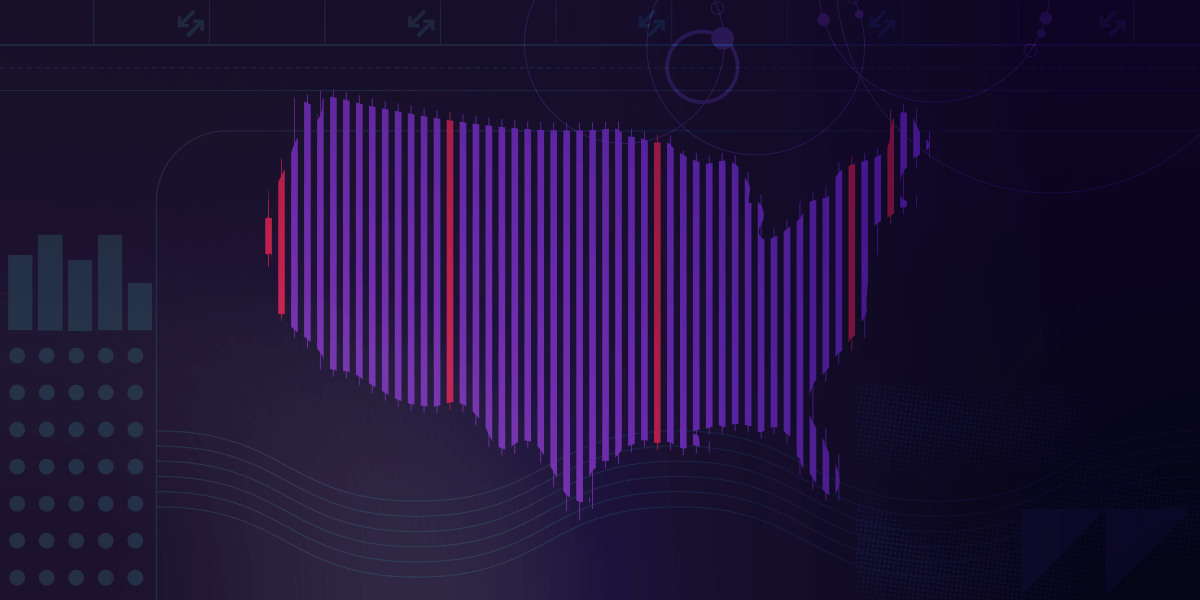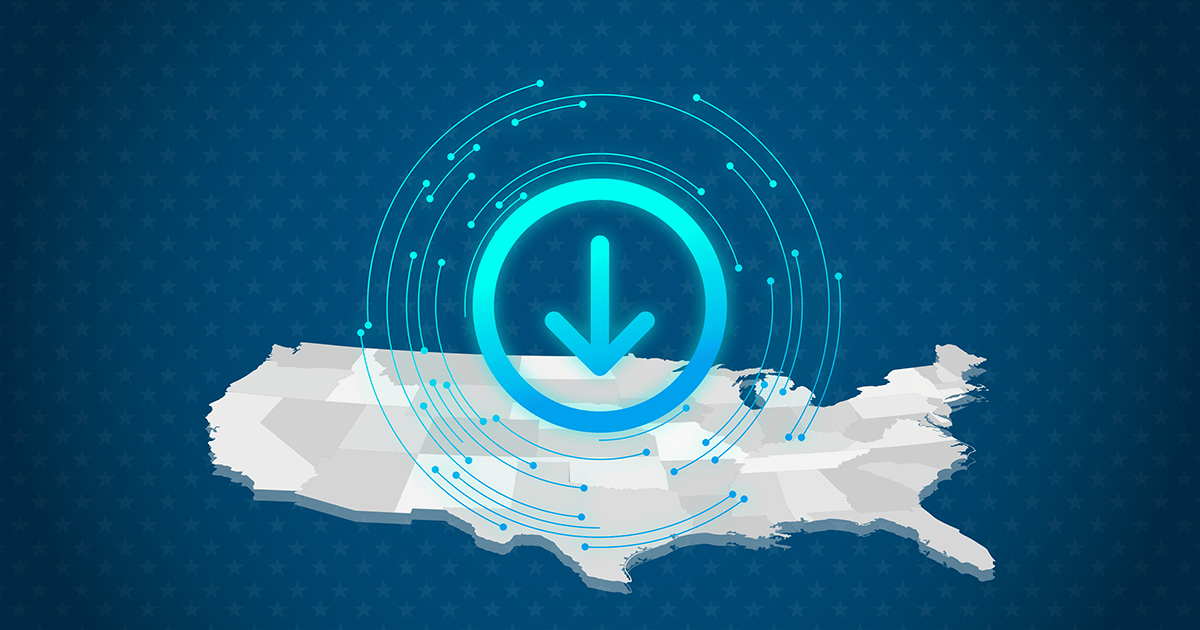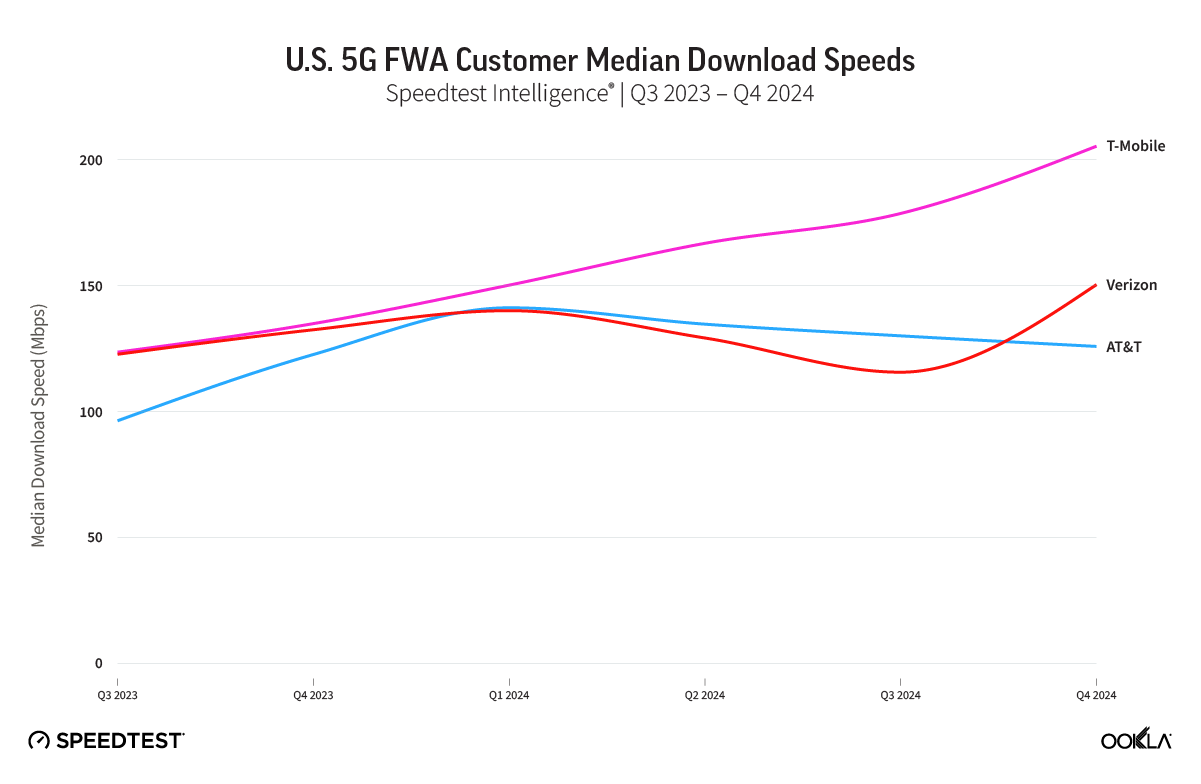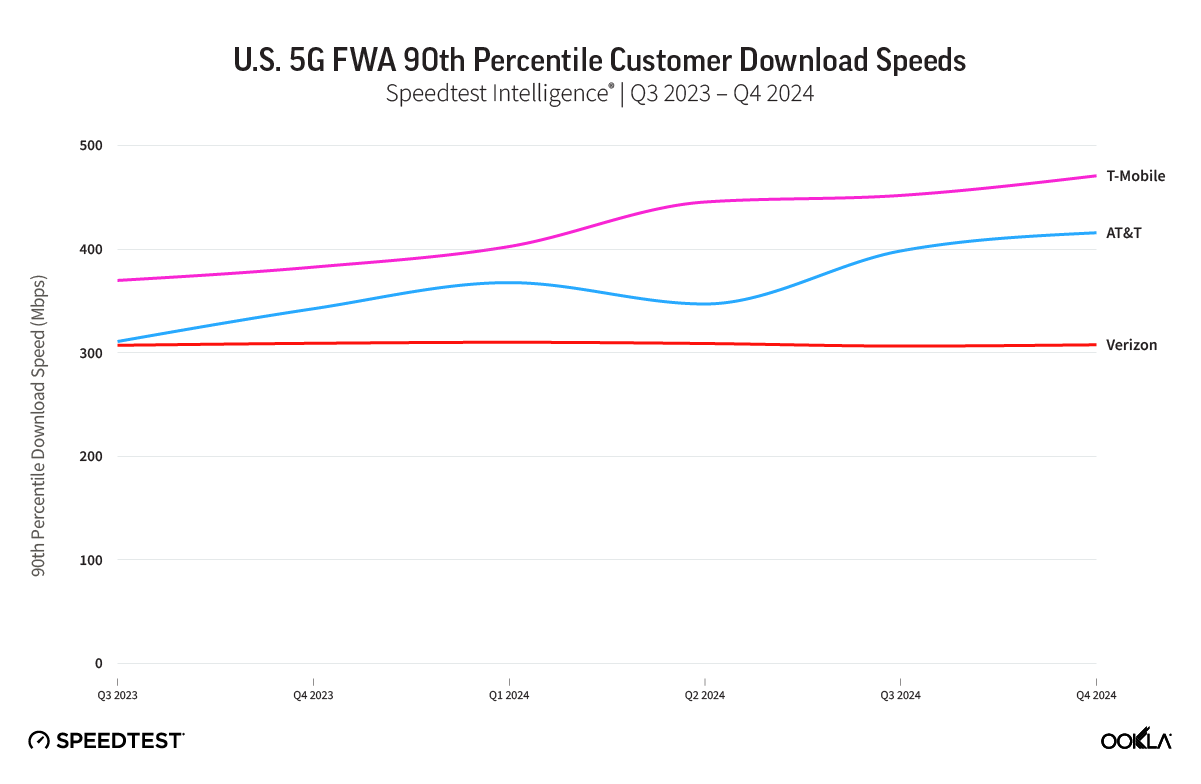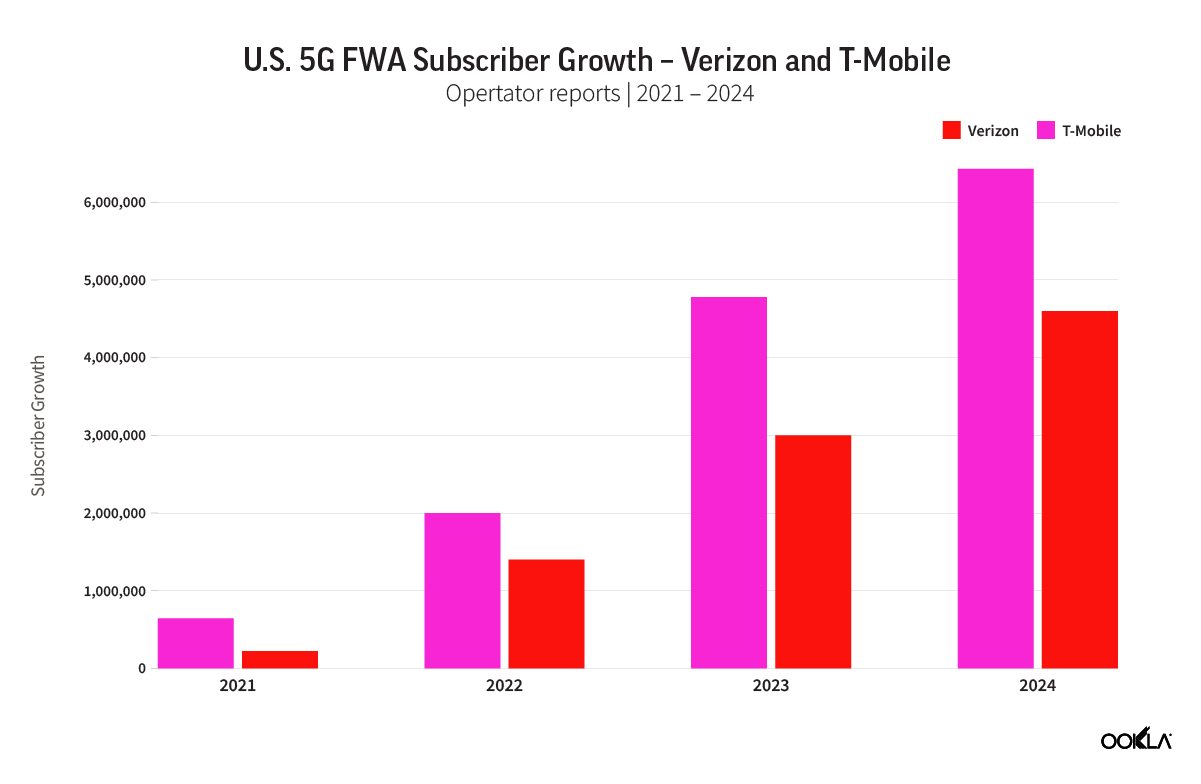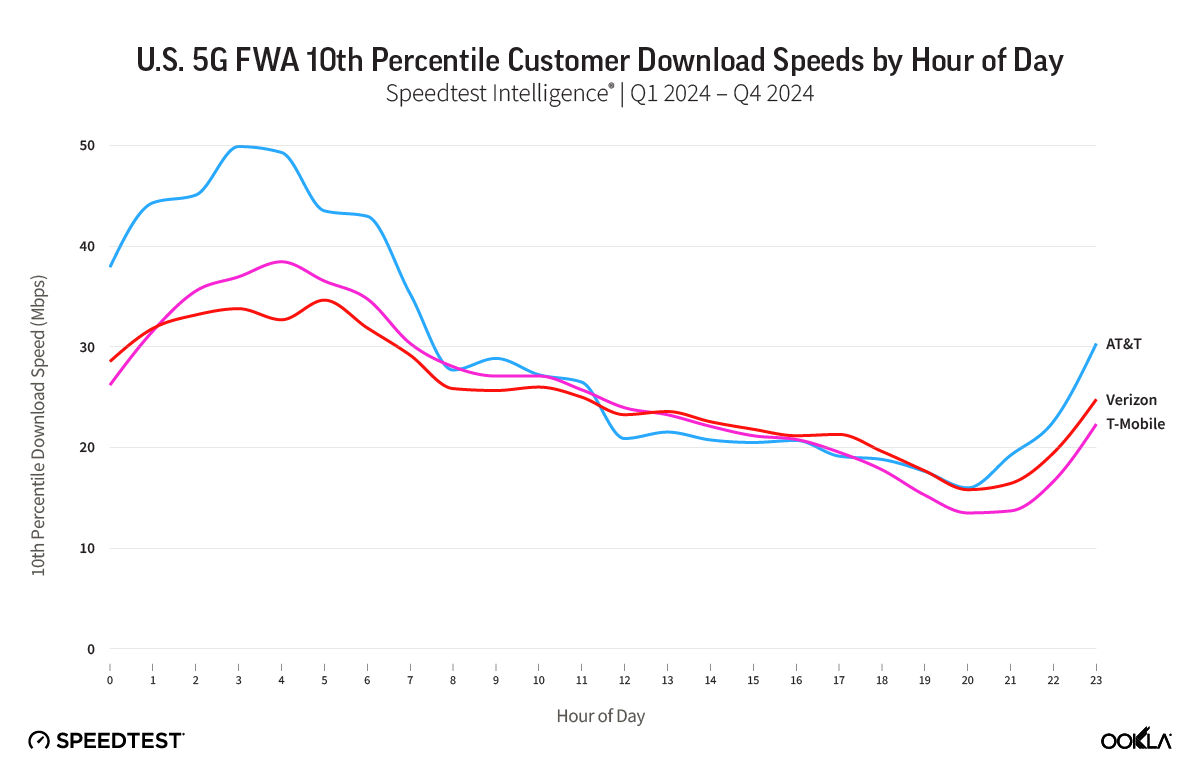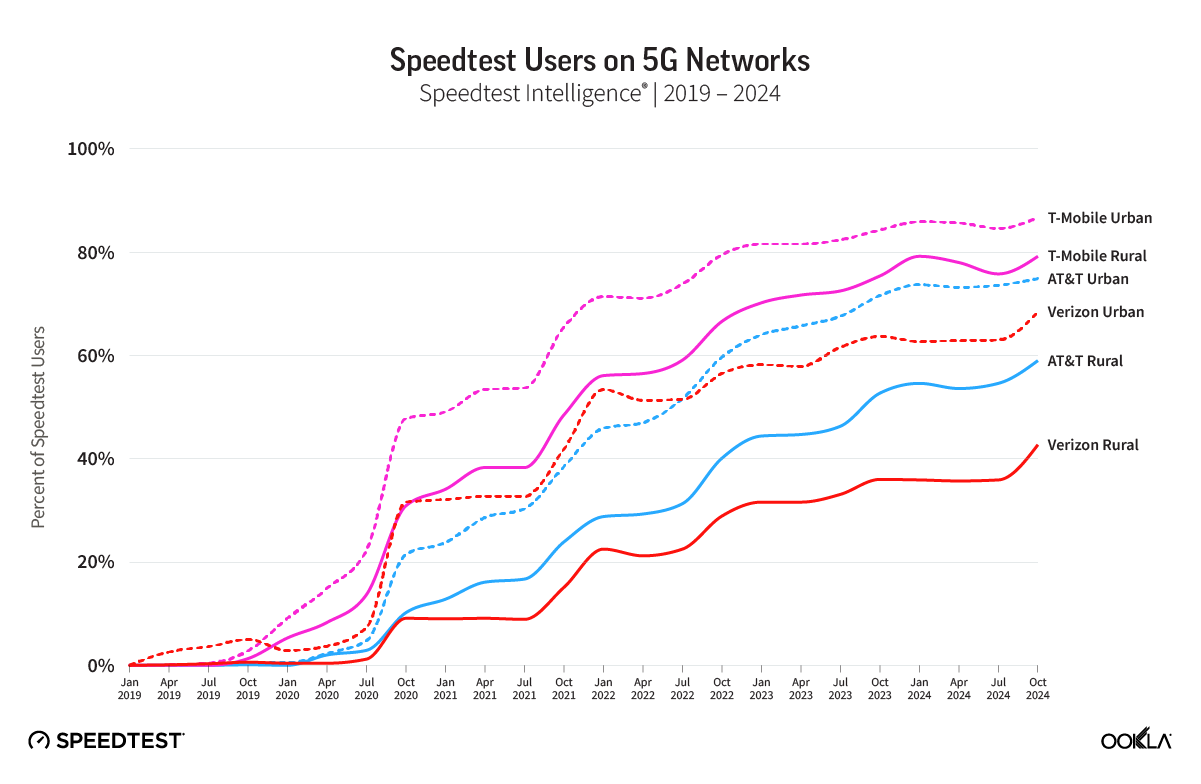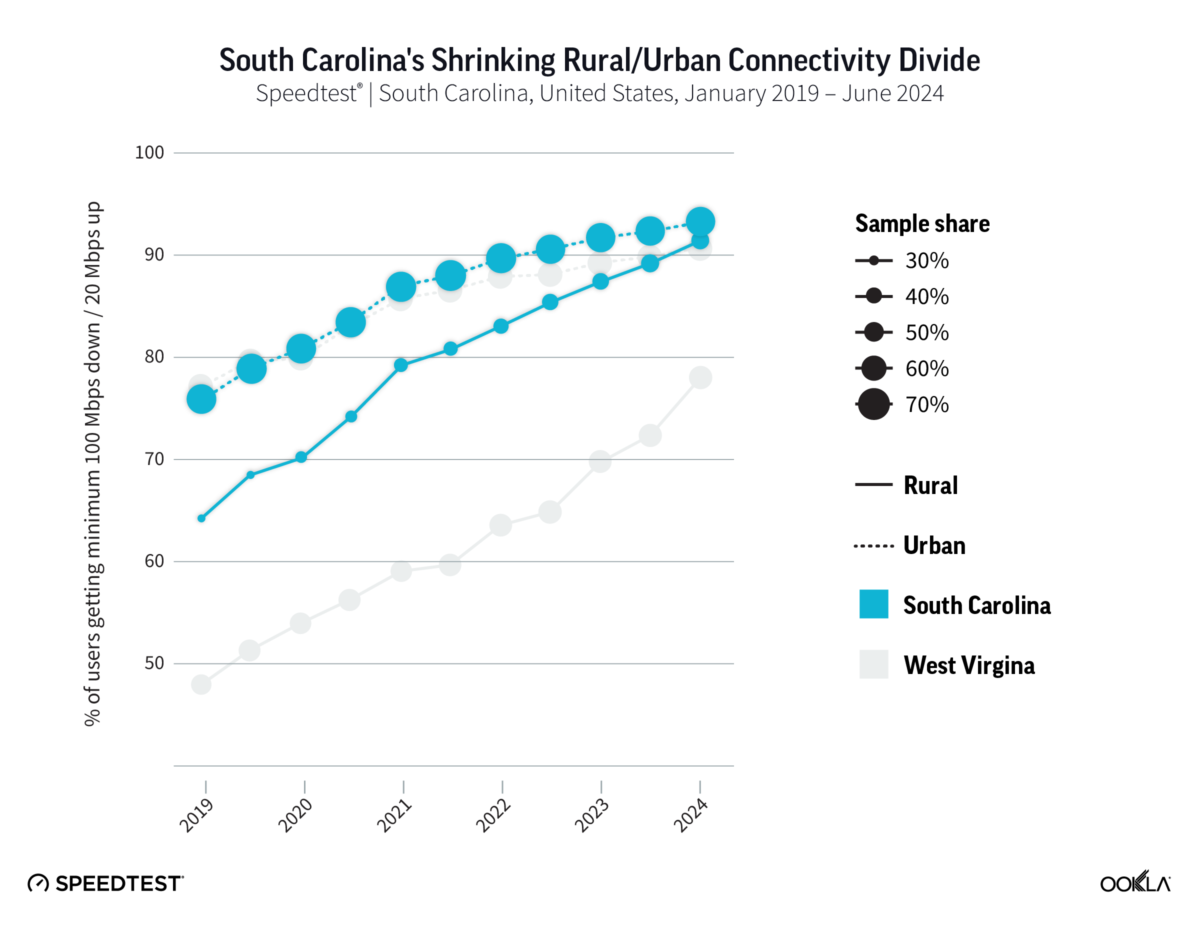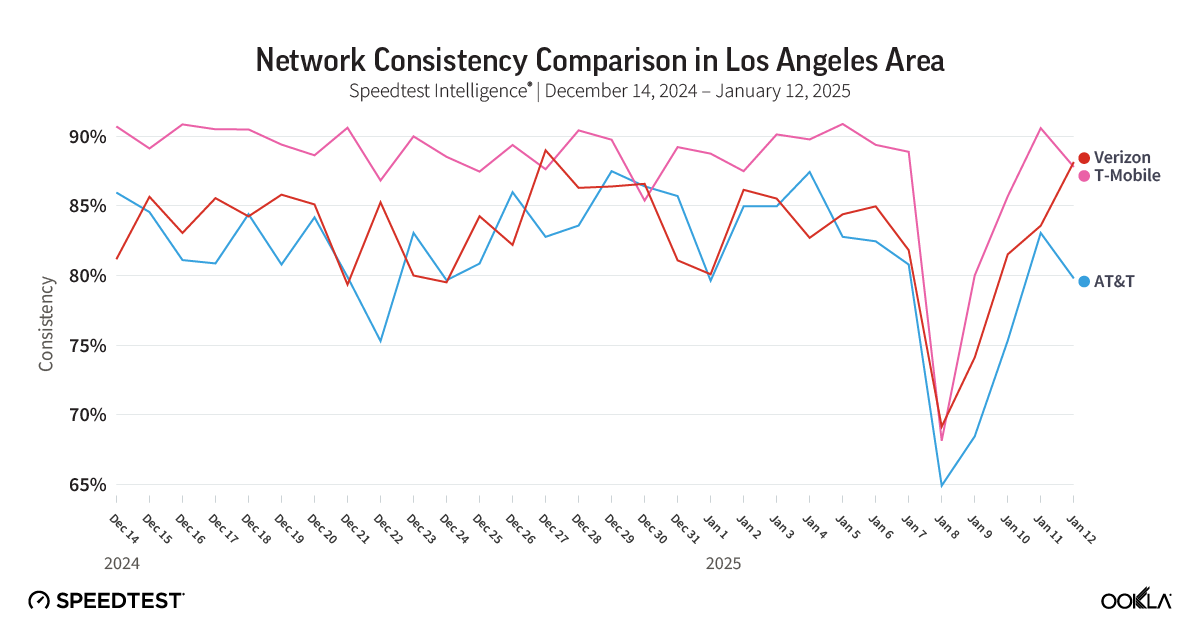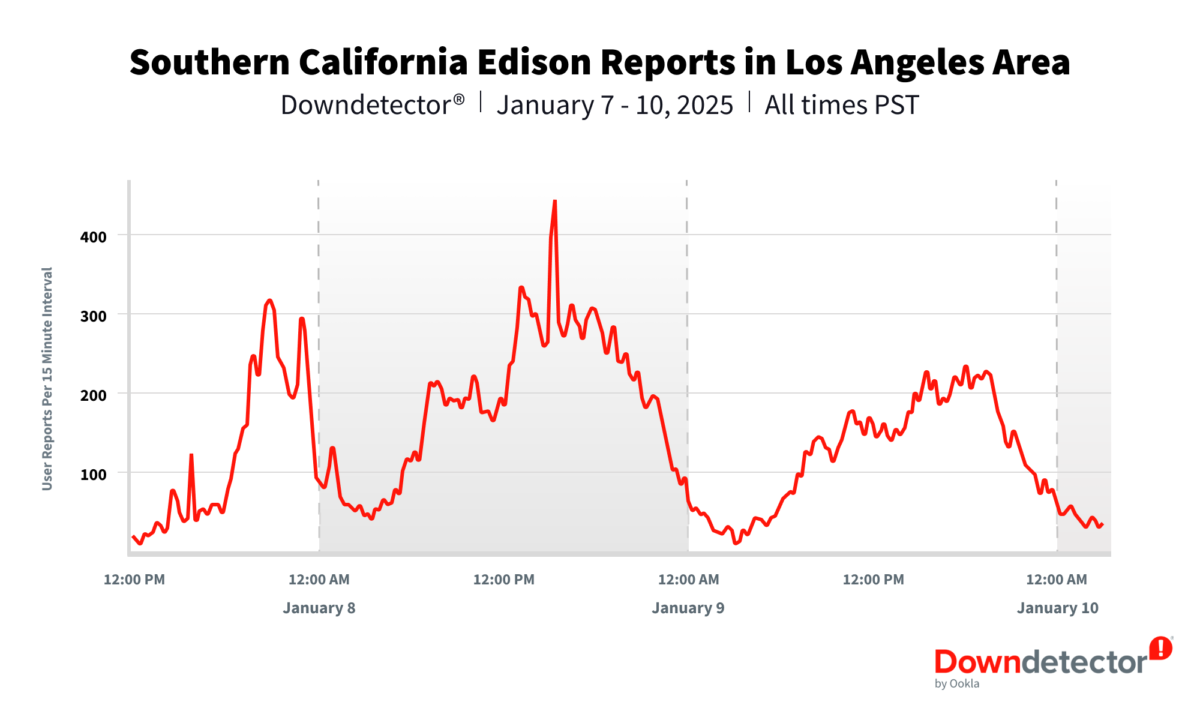The LEO satellite provider is giving free gear to new customers in areas where it has excess capacity. Will it be able to handle an influx of new customers and still maintain its broadband speeds?
Key Takeaways
- Users on Starlink’s network experienced median download speeds nearly double from 53.95 Mbps in Q3 2022 to 104.71 Mbps in Q1 2025. Median upload speeds also increased dramatically during the same period from 7.50 Mbps in Q3 2022 and to 14.84 Mbps in Q1 2025.
- Only 17.4% of U.S. Starlink Speedtest users nationwide were able to get broadband speeds consistent with the FCC’s minimum requirement for broadband of 100 Mbps download speeds and 20 Mbps upload speeds. However, this small percentage of Starlink users is primarily due to its low upload speeds.
- Speedtest® data for the states where Starlink is offering its free equipment to new users indicates that existing Starlink users are experiencing a range of median download speeds — from as high as 136.93 Mbps in Maine to as low as 72.65 Mbps in Alaska.
- With Starlink’s substantial increase to its median upload and download speeds and ability to deliver broadband speeds of 100/20 Mbps to nearly 20% of Speedtest users across the country, the satellite provider is becoming an increasingly attractive broadband option for many.
SpaceX’s low-Earth orbit (LEO) satellite provider Starlink is making inroads in the U.S. broadband market and trying to attract more subscribers by offering free equipment to new customers in states where it says it has excess capacity (more on this below).
Ookla® Speedtest data on Starlink indicates that the satellite company’s network performance has been on the uptick over the past couple of years and as of Q1 2025 17.42% of U.S. Starlink Speedtest users were able to get speeds consistent with the FCC’s minimum requirement for fixed broadband of 100 Mbps download speeds and 20 Mbps upload speeds.
Starlink is positioned to benefit from recent changes to the Broadband Equity, Access and Deployment (BEAD) program. The National Telecommunications and Information Administration (NTIA) announced June 6 that it had reviewed the BEAD program and, as expected, it adopted a technology-neutral stance instead of prioritizing fiber deployments, making way for LEO satellite systems like Starlink to get BEAD funding.
In addition, some states such as Maine have launched state-funded programs that subsidize Starlink for some rural addresses and more are likely to follow. The Texas Broadband Development Office, for example, announced in January 2025 that it is developing a grant program to support LEO satellite broadband service in rural areas.
Starlink Upload, Download Speeds Are On the Rise
Starlink’s network performance over the past three years shows a dramatic increase in median download and upload speeds as well as a decline in latency.
Starlink’s performance across the U.S. from Q1 2022 until Q1 2025 indicates that after experiencing a decline in download speeds between Q1 2022 and Q3 2022, U.S. Speedtest users on Starlink’s network saw a median download speeds nearly double from 53.95 Mbps in Q3 2022 to 104.71 Mbps in Q1 2025.
The decline in median download speeds between Q1 2022 and Q3 2022 was likely due to growing pains as the satellite service added more subscribers and network usage increased.
A similar trend was observed in median upload speeds as Speedtest users saw their median upload speeds decline between Q1 2022 from 9.81 Mbps to 7.50 Mbps in Q3 2022 and then tick upward to Q1 2025 when median upload speeds reached 14.84 Mbps.
Starlink's Median Upload, Download and Latency Speeds
Q1 2022 through Q1 2025
Starlink's Median Upload, Download and Latency Speeds Over Time
Starlink’s Latency Ticks Downward
Perhaps more importantly than download and upload speeds is latency, which is the time it takes to transmit data from one point in the network to another. Transmitting data between earth and space is particularly challenging because of the distance involved. However, because Starlink’s satellites orbit the planet in low-orbit (about 340 miles above the earth) its latency is much lower than geostationary satellite systems that orbit about 22,000 miles above the earth. For example, signals from satellite system such as HughesNet have a much greater distance to travel, which is why Speedtest users on HughesNet experience a much higher median latency than Starlink Speedtest users.
A comparison of Starlink's Median Latency with HughesNet's Median Latency
Q1 2022 through Q1 2025
Starlink's low-Earth orbit median latency compared with geostationary satellite system's median latency
Starlink users in the U.S. experienced a median multi-server latency of 76 milliseconds (ms) in Q2 2022, but latency measurements ticked downward over time and in Q1 2025 Speedtest users clocked an average median latency of 45 ms.
Starlink said in March 2024 that it was improving its latency in the U.S. by adding six additional internet connection locations (also referred to as PoPs) and optimizing its gateway locations and its planning algorithms to ensure that traffic lands as close to its destination point as possible.
In addition, the satellite company has also steadily added more satellites to its constellation. In February 2022 Starlink had 1,560 satellites in orbit and as of February 2025 it had 6,751 satellites in orbit. At publication of this report, Starlink had launched an additional 24 satellites into low Earth orbit.
Starlink’s New Free Equipment Offer Targets Several States
Starlink recently announced plans to offer free equipment (valued at around $350) to new customers in areas where it has excess capacity. In the U.S., those areas are depicted on the map below and include all or portions of about 33 states.
Customers who receive the free gear must commit to a one-year plan, and they have a choice of one of two residential plans: An $80/mo plan that will give them speeds between 50-100 Mbps and a $120/mo plan that provides speeds of 250 Mbps.
Ookla Speedtest data for the states where Starlink is offering the free equipment indicates that existing Starlink users are experiencing a range of median download speeds — from as high as 136.93 Mbps in Maine to as low as 72.65 Mbps in Alaska. Perhaps more telling is the download speeds for Speedtest users in the 25th percentile, which provides the download speed performance for the bottom quarter of Speedtest users in these states.
With the exception of Alaska, the overall performance of the rest of the states, particularly the 25th percentile users in Nebraska, Colorado, Maine, Massachusetts, Nevada and Wyoming is probably a better indication of why Starlink is offering free gear to these states. With the 25th percentile of Starlink users in these states experiencing download speeds of more than 80 Mbps there is likely plenty of excess capacity.
Although Starlink said its goal is to deliver service with just 20 milliseconds (ms) median latency, the lowest median latency rates recorded by Speedtest users in all or portions of the selected states was 38 ms in the District of Columbia and 39 ms in Arizona, Colorado and New Jersey. Alaska and Hawaii have the highest latency rates of 105 ms and 115 ms respectively. The higher latency rates in these two states is likely due to these two states being more geographically distant from Starlink’s constellation of satellites and not having the same density of satellites as the continental U.S.
Speedtest Performance for Starlink Users in States that Get Free Gear
The portions or entirety of 33 states or territories where Starlink has decided to offer free gear to potential customers include both high density areas such as Washington D.C. and New Jersey as well as low density states like Alaska and Wyoming. With the exception of Alaska and West Texas, all of the states have a median download speed of more than 100 Mbps.
When looking at the 25th percentile of users (which are the bottom quarter of Starlink users in download speed performance) only one state – Alaska– has a download speed in the 30 Mbps range and three states have 25th percentile users getting in the 50 Mbps range for download speeds.
In addition, when it comes to latency, 20 states have a median latency between 40-49 ms and two states on this list—Arizona and New Jersey— and Washington, D.C. —have median latency under 40 ms.
Starlink Speedtest Performance In the 50 U.S. States
How each state performs in latency, median download, and 25th percentile download
Starlink's performance in latency, median download, and 25th percentile download in all 50 states in the U.S.
Speedtest Performance in States Not Included in Starlink’s Free Equipment Offer
Many of the states where residents are not eligible to get Starlink’s free equipment offer are in the middle and southeastern areas of the U.S. and only eleven of those states have median download speeds over 100 Mbps compared to 28 states and Washington, D.C. that are in the eligible equipment list.
Median latency rates in these ineligible states are very similar to the eligible states with 14 states having a median latency rate between 40- 49 ms. However, when examining the 25th percentile of users (which are the bottom quarter of Starlink users in download speed performance) one state — Florida — has 25th percentile download speeds of just 27.12 Mbps, Washington has 25th percentile download speeds of 46.92 Mbps and Louisiana has 25th percentile download speeds of just 48.25 Mbps.
Northeast and Rural Mid-West States Win in Minimum Broadband Speeds
Only 17.4% of Starlink Speedtest users are able to get broadband speeds consistent with the FCC’s minimum requirement for broadband of 100 Mbps download speeds and 20 Mbps upload speeds. Much of this is due to Starlink’s low upload speeds, which are on the uptick but with a combined overall median upload speed of 14.84 Mbps in Q1 2025 there is still room for improvement.
However, when we look at all satellite providers that deliver service in the U.S., these providers combined are only able to provide 15.75% of Speedtest users with speeds that meet the FCC’s minimum requirement of 100/20 Mbps, which means Starlink outperforms the other providers in this category.
On a state level analysis, when comparing the median download and upload speeds collected in Q1 2025 across all 50 states and Washington, D.C., South Dakota is the No. 1 state with 42.3% of Starlink users getting the FCC’s minimum standard for fixed broadband speeds (100 Mbps downstream/20 Mbps upstream). All of the top-performing Starlink states are in the Northeastern and Midwestern U.S.
On the opposite end of the spectrum, the states with the lowest percentage of users receiving 100/20 Mbps broadband speeds are primarily in the Southeastern U.S. The only state outside of that area is Alaska with the smallest number of Speedtest users —just 5.3%—receiving 100/20 Mbps.
States With the Highest % of Starlink Users that Receive 100/20 Mbps Broadband Speeds
| State | % of Starlink users that receive 100/20 Mbps |
| South Dakota | 42.3 |
| Rhode Island | 39.0 |
| Wyoming | 38.5 |
| Maine | 36.5 |
| Massachusetts | 35.1 |
States with the Lowest % of Starlink Users that Receive 100/20 Mbps Broadband Speeds
| State | % of Starlink users that receive 100/20 Mbps |
| Alaska | 5.3 |
| Mississippi | 8.4 |
| Louisiana | 9.0 |
| Arkansas | 9.6 |
| Florida | 9.8 |
Starlink Delivers a Viable Broadband Option for Many
In our recent U.S. state broadband report which focused on Speedtest data from the 2H of 2024, we found that the number of states with 60% or more of Speedtest users getting speeds of 100/20 Mbps had increased substantially from the 1H of 2024.
However, it was disheartening to discover that during that same time period the digital divide within many states had actually increased (some of this is attributed to the demise of the Affordable Connectivity Program) rather than decreased leading us to conclude that many of the recent broadband investments were resulting in better urban coverage rather than closing the gap in rural areas.
With Starlink’s substantial increase to its median upload and download speeds and ability to deliver broadband speeds of 100/20 Mbps to nearly 20% of Speedtest users across the country, the satellite provider is becoming an increasingly attractive broadband option for many.
With Starlink’s latest promotional offer of free equipment to consumers in areas where it has excess capacity, we expect to see the company’s subscriber count grow throughout 2025. It will be interesting to see how the LEO provider balances subscriber growth with capacity.
We will continue to monitor Starlink’s speed performance in the U.S. throughout the year. For more information about Speedtest Intelligence® data and insights, please get in touch.
Ookla retains ownership of this article including all of the intellectual property rights, data, content graphs and analysis. This article may not be quoted, reproduced, distributed or published for any commercial purpose without prior consent. Members of the press and others using the findings in this article for non-commercial purposes are welcome to publicly share and link to report information with attribution to Ookla.




